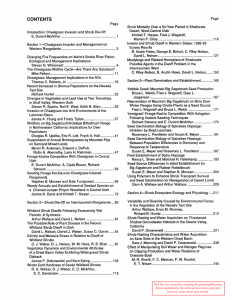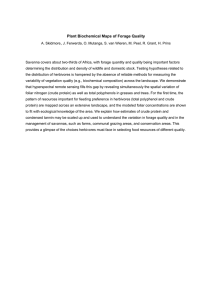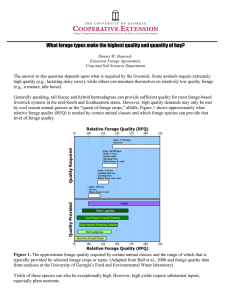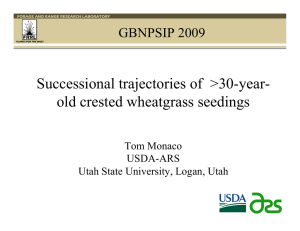Document 14092667
advertisement
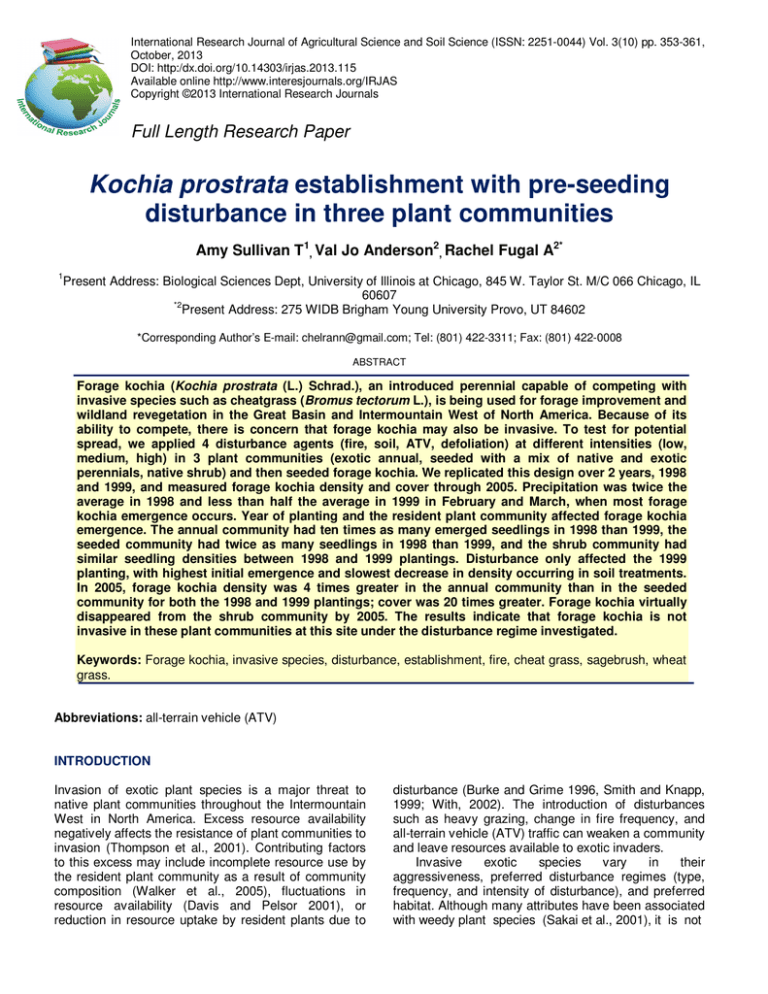
International Research Journal of Agricultural Science and Soil Science (ISSN: 2251-0044) Vol. 3(10) pp. 353-361, October, 2013 DOI: http:/dx.doi.org/10.14303/irjas.2013.115 Available online http://www.interesjournals.org/IRJAS Copyright ©2013 International Research Journals Full Length Research Paper Kochia prostrata establishment with pre-seeding disturbance in three plant communities Amy Sullivan T1, Val Jo Anderson2, Rachel Fugal A2* 1 Present Address: Biological Sciences Dept, University of Illinois at Chicago, 845 W. Taylor St. M/C 066 Chicago, IL 60607 *2 Present Address: 275 WIDB Brigham Young University Provo, UT 84602 *Corresponding Author’s E-mail: chelrann@gmail.com; Tel: (801) 422-3311; Fax: (801) 422-0008 ABSTRACT Forage kochia (Kochia prostrata (L.) Schrad.), an introduced perennial capable of competing with invasive species such as cheatgrass (Bromus tectorum L.), is being used for forage improvement and wildland revegetation in the Great Basin and Intermountain West of North America. Because of its ability to compete, there is concern that forage kochia may also be invasive. To test for potential spread, we applied 4 disturbance agents (fire, soil, ATV, defoliation) at different intensities (low, medium, high) in 3 plant communities (exotic annual, seeded with a mix of native and exotic perennials, native shrub) and then seeded forage kochia. We replicated this design over 2 years, 1998 and 1999, and measured forage kochia density and cover through 2005. Precipitation was twice the average in 1998 and less than half the average in 1999 in February and March, when most forage kochia emergence occurs. Year of planting and the resident plant community affected forage kochia emergence. The annual community had ten times as many emerged seedlings in 1998 than 1999, the seeded community had twice as many seedlings in 1998 than 1999, and the shrub community had similar seedling densities between 1998 and 1999 plantings. Disturbance only affected the 1999 planting, with highest initial emergence and slowest decrease in density occurring in soil treatments. In 2005, forage kochia density was 4 times greater in the annual community than in the seeded community for both the 1998 and 1999 plantings; cover was 20 times greater. Forage kochia virtually disappeared from the shrub community by 2005. The results indicate that forage kochia is not invasive in these plant communities at this site under the disturbance regime investigated. Keywords: Forage kochia, invasive species, disturbance, establishment, fire, cheat grass, sagebrush, wheat grass. Abbreviations: all-terrain vehicle (ATV) INTRODUCTION Invasion of exotic plant species is a major threat to native plant communities throughout the Intermountain West in North America. Excess resource availability negatively affects the resistance of plant communities to invasion (Thompson et al., 2001). Contributing factors to this excess may include incomplete resource use by the resident plant community as a result of community composition (Walker et al., 2005), fluctuations in resource availability (Davis and Pelsor 2001), or reduction in resource uptake by resident plants due to disturbance (Burke and Grime 1996, Smith and Knapp, 1999; With, 2002). The introduction of disturbances such as heavy grazing, change in fire frequency, and all-terrain vehicle (ATV) traffic can weaken a community and leave resources available to exotic invaders. Invasive exotic species vary in their aggressiveness, preferred disturbance regimes (type, frequency, and intensity of disturbance), and preferred habitat. Although many attributes have been associated with weedy plant species (Sakai et al., 2001), it is not 354 Int. Res. J. Agric. Sci. Soil Sci. yet possible to accurately predict whether an introduced plant species will be invasive in a particular area based solely on phylogenetic or morphologic traits (Williamson 1999, Radosevich et al., 2005). Disturbance can be an important factor in the spread and persistence of exotic invasive species in native communities (Petryna et al., 2002, Gelbard and Belnap, 2003). Additionally, some exotic species exploit some types of disturbance better than others. For example, a study of two invasive cruciferous forbs in Germany (Bunias orientalis and Rorippa austriaca) indicated that one increased with soil disturbance, while the other increased at mown sites (Woitke and Dietz, 2002). If a disturbance regime favors the establishment and reproduction of an exotic species, that species may be able to establish and increase in communities where the disturbance regime exists. ‘Immigrant’ forage kochia (Kochia prostrata (L.) Schrad.), a semi-evergreen subshrub in the goosefoot (Chenopodiaceae) family, was originally introduced from Russia to compete with halogeton (Halogeton glomeratus (Bieb.) C.A. Mey) and was released in 1984 (Stevens et al., 1984; Tilley et al., 2006). Many consider it desirable in western North American rangeland rehabilitation because it provides good forage (7-14% crude protein during fall and winter months, Davis 1979), is adapted to semi-arid lands, is fire tolerant, remains high in moisture during the fire season making it useful in greenstripping (Harrison et al., 2002), and is competitive with exotic invasive annuals such as cheatgrass (Bromus tectorum L.) (McArthur et al., 1990, Monsen and Turnipseed, 1990), halogeton (Stevens and McArthur, 1990), Russian thistle (Salsola tragus L.), and medusahead (Taeniatherum caput-medusae (L.) Nevski) (Stevens et al., 1985; Tilley et al., 2006). Because of these attributes, some scientists see forage kochia as a solution to a multitude of problems facing wildlands in the Great Basin and Intermountain West of North America (McArthur et al., 1990; Clements et al., 1997), while others view forage kochia as a potentially invasive species (Mack, 1999). The objective of this study was to evaluate the invasiveness of forage kochia by studying the effect of 4 different disturbance agents applied as single pre-seeding events on forage kochia emergence and persistence in 3 different plant communities: one dominated by annual grass, one dominated by perennial grasses, and one dominated by perennial shrubs. by a native shrub community prior to 1994 when a fire removed most of the vegetation. The soil (Hiko Peak – Checkett complex) a deep, well-drained, gravelly loam, is fairly suited to range seeding (Soil Survey Staff 2007) with low precipitation (174 mm/year, NOAA 1999) and competing vegetation being the main factors limiting success (Soil Survey Staff 2007). Subsequent to the burn, one part of the area was rehabilitated by drill-seeding a mix of natives and non-natives and is now dominated by crested wheatgrass, sandberg bluegrass, rubber rabbit brush, and sagebrush (Tab. 1). The untreated portion now supports an exotic annual community dominated by cheatgrass, with some bur buttercup, and Russian thistle interspersed (Tab. 1). A remnant of the unburned native sagebrush community (Tab. 1) also exists next to the treated and untreated burn. The result is an area with 3 adjacent community types: exotic annual (hereafter referred to as annual), seeded, and native shrub (hereafter referred to as shrub). This combination of communities on a large scale presents an unusual and valuable research opportunity with some notable limitations. Because the 3 communities were not created for the purpose of this research, but rather developed as a product of nature and practical management, these sites better represent existing rangeland. At the same time, it must be acknowledged that subtle differences in topography, soil, and vegetation may have influenced the location of the burn. Topography as well as resource limitations also likely affected where the drill-seeding took place. In addition to the differences in plant community composition, these differences may have influenced the results but we maintain that they do not compromise the practical utility of this research. Plant community is one of the most obvious measurable indicators and is used throughout the Intermountain West to differentiate one site from another. We only wish to acknowledge the fact that there are likely other influential site characteristics that affect not only the plant community but its response to disturbance and invasion. Caution with interpretation is necessary mainly due to the fact that there was no opportunity to replicate the study site. Thus, comparisons between plant communities must be taken as suggestive and limited to the site rather than definitive and broadly applicable. Although caution is necessary in the interpretation of the results of such an experimental design, the data are still a valuable contribution to our understanding of forage kochia. Design MATERIALS AND METHODS Study Site Located on Dugway Proving Ground in western Utah (40°15′13.74″ N latitude, 112°49′09.01 W longitude), the study site was historically characterized Three blocks of 15, 2 x 2 m plots were established in each of the 3 communities. Four disturbances (fire, soil, ATV, and defoliation) were applied at 3 different levels (low, medium, and high), resulting in 12 disturbance treatments in addition to 3 control plots. The plots were randomly assigned within each block, though the ATV Sullivan et al. 355 Table 1. Average vegetation aerial cover (%) and standard errors (in parentheses) for 3 adjacent plant communities at Dugway, UT. (Gardner, 2009) Picrothamnus desertorum Nutt. Artemisia tridentata Nutt. budsage big sage Native Shrub 11.4 (2.1) - Atriplex canescens (Pursh) Nutt. 4-wing saltbush Atriplex confertifolia (Torr. & Frém.) S. shadscale 1.7 (0.9) Wats. Ericameria nauseosa (Pallas ex Pursh) rubber rabbitbrush Nesom & Baird Chrysothamnus viscidiflorus (Hook.) Nutt. douglas rabbitbrush 0.2 (0.2) Shrub total 13.3 (2.3) Phlox hoodii Richards. spiny phlox Sphaeralcea munroana (Dougl. ex Lindl.) munroe’s Spach ex Gray globemallow Forb total Agropyron cristatum L. crested wheatgrass Elymus elymoides (Raf.) Swezey squirreltail 0.08 (0.1) Poa secunda J. Presl sandberg bluegrass 0.01 (0.01) Achnatherum hymenoides (Roemer & indian ricegrass 0.45 J.A. Schultes) Barkworth (0.2) Perennial grass total 0.5 (0.2) Bromus tectorum L. cheatgrass 12.3 (2.2) Ceratocephala testiculata (Crantz) Bess. bur buttercup 0.1 (0.03) Salsola tragus L. Russian thistle Sisymbrium altissimum L. tumble mustard 0.01 (0.01) Annual weed total 12.4 (2.2) disturbance treatment was restricted to the outside plots to facilitate ATV access. The fire disturbance was applied using a propane torch to burn the vegetation in the plot. The low-level fire treatment consisted of scorching the fine vegetation close to the ground leaving some live material. All fine vegetation was burned and the shrubs lightly scorched for the medium-level treatment. All vegetation in the plot was burned to the ground in the high-level fire treatment. The soil disturbance was created using a shovel to invert soil at approximately 20 cm depth uprooting herbaceous vegetation and disturbing some shrub roots. The soil texture (gravelly loam) created minimal clods and air pockets. Less than 25% of the plot was overturned in the low level, approximately 50% for the medium, and more than 75% in the high. The ATV disturbance treatment consisted of one pass of the Seeded 0.01 (0.01) Exotic Annual - 4 (1.4) - 0.7 (0.6) - 0.05 (0.05) - 5 (1.7) - - - 9.7 (2.3) - 0.1 (0.07) - - 0.02 (0.01) 0.1 (0.07) 3 (0.6) 0.02 (0.01) - 0.3 (0.1) - 1.6 (0.5) - 0.01 (0.01) - 4.9 (0.9) - 2.3 (0.8) 54.6 (3.1) 0.1 (0.02) 0.01 (0.01) 0.01 (0.01) 0.5 (0.2) - - 2.3 (0.8) 55.1 (3.02) ATV with almost no vegetation or soil disturbance for the low-level treatment, several passes (5-10) resulting in vegetation disturbance but little soil disturbance for the medium-level, and many passes (25-35) to the point where soil surface disturbance was considerable and the vegetation in the tracks was demolished for the high-level. The defoliation disturbance was created using a gas-powered weed-eater. The low level treatment consisted of removing 50% (height) of the vegetation in the annual (consisting of actively growing fall-germinated cheatgrass) and seeded plots and removing only the easily accessible herbaceous understory in the shrub plots. The medium consisted of removing 75% (height) of the vegetation in the annual and seeded plots and removing the herbaceous understory and lightly clipping the shrubs in the shrub plots. The high level was created by removing all Precipitation (mm) 356 Int. Res. J. Agric. Sci. Soil Sci. Figure 1. Monthly precipitation recorded in 1998 (dark bars) and 1999 (clear bars) at Dugway Proving Ground, Utah. The line represents the 36-year mean. vegetation to the ground in the annual and seeded plots, and removing all herbaceous vegetation as well as most of the shrub foliage in the shrub plots. Two weeks after treatment application, forage kochia was seeded on 29-30 January 1998 (hereafter referred to as the 1998 planting). A replicate of this experiment was installed with treatments applied 2 weeks prior to planting on 16-17 February 1999 (hereafter referred to as the 1999 planting). The winter seeding with forage kochia seed collected in Ephraim, Utah the November before planting both years was in accordance with recommendations for best establishment (Tilley et al. 2006). Precipitation varied in pattern and amount between 1998 and 1999 (Fig. 1) with February-March receiving more than twice the average precipitation in 1998 (85.9 mm; 36-year average is 32.5 mm) and only 30% of average in 1999 (9.7 mm) (NOAA 1999). To simulate the seed density and dispersal of mature plants in a rangeland setting where stands are not pure and to ensure an even dispersal across the plots, a 17.5 kg PLS/ ha seeding rate was used for both plantings. To achieve this, 3.5 g PLS were evenly broadcast by hand over each 2 m2 plot. A 2 x 2 m PVC pipe quadrat subdivided into 100, 20 x 20 cm squares was used to collect data. We used a stratified random sampling design and collected data from 24 20 x 20 cm squares in each quadrat. In each square, live forage kochia seedlings were counted, and forage kochia cover estimated. The data from these squares were averaged to yield forage kochia density and cover for each 2 x 2 m plot. Density and cover data were collected in June 1998, 1999, 2000, and 2002, and May 2005. Statistical Analysis Data were analyzed using SYSTAT 10 (Systat, 2000). Density data were square root transformed prior to analyses to adjust for the Poisson distribution. Initial analyses showed disturbance level was not significant, so all levels were combined into one average of each disturbance type per block for analyses. A multivariate analysis of variance (MANOVA) was performed for both plantings together with density and cover from the first census for each planting (1998 and 1999 designated year 1 for the first and second plantings respectively) as dependent variables and planting, plant community, and treatment as independent variables. An additional MANOVA was done for both plantings together with density and cover from the last census for each planting (May 2005) as the dependent variables and planting, community, and treatment as independent variables. Repeated measures analyses of variance (ANOVAs) were performed separately for the 1998 and 1999 plantings with forage kochia density for each census as the dependent variables and community and treatment as the independent variables. Figures are presented using back-transformed means and standard errors for ease of interpretation. RESULTS Density Forage kochia seedling emergence differed between planting years in relation to community and disturbance treatment. The 1998 planting had more seedlings Sullivan et al. 357 1998 Forage Kochia Planting 200 Density (#/m2) 150 Annual 100 Seeded Shrub 50 0 1998 1999 2000 2002 2005 Figure 2. Forage kochia density in 3 plant communities over time following the 1998 planting at Dugway Proving Ground, Utah. Repeated measures ANOVA: community F8, 408 = 22.595, p <0.001. Bars represent standard error. overall, with the highest density in the seeded community and lowest in the shrub community (Fig. 2). In contrast, seedling density remained highest in the seeded community in the 1999 planting and was lowest in the annual community (MANOVA: planting by community F2,204 = 42.617, P <0.001) (Fig. 3). Forage kochia emergence was unaffected by disturbance treatment in the 1998 planting, while in the 1999 planting, the soil treatment had more seedlings than the other treatments or control (MANOVA: planting by treatment F4,204 = 2.662, P <0.05) (Fig. 3). Plant community was the only factor that had a significant effect on forage kochia density for the duration of the study (1998-2005) for the 1998 planting. Forage kochia density decreased less steeply and leveled to 25 individuals/m2 in the annual community, while it decreased to nearly 0 in the shrub community (Repeated measures ANOVA: community F8, 408 = 22.595, P <0.001) (Fig. 2). In contrast, forage kochia density in the 1999 planting for the duration (1999 to 2005) was influenced by a treatment by community interaction (Repeated measures ANOVA: F24, 306 = 1.630, P <0.05) (Fig. 3). In the annual community, density initially decreased and then steadily increased to the end of the study. In contrast, density declined to almost zero in the seeded and shrub community. However, forage kochia decreased at a slower pace in soil treatments in the seeded and shrub communities. Cover During the first year of data collection, forage kochia cover was higher in the shrub community (1.5%) of the 1998 planting than either of the other communities (both approximately 0.5% cover) of that planting. Cover in the 1999 planting was lowest in the annual community (<0.025%) with cover in the seeded and shrub communities similar to each other (approximately 0.5 %). Cover was highest in the soil treatments of all 3 communities in the 1999 planting (MANOVA: community by treatment by planting F8, 204 = 3.281, P <0.01). At the last data collection of the 1999 planting in 2005, cover was highest in the annual community (18.5 2.0 %), followed by the seeded (1.2 0.4%), with almost no cover in the shrub community (0.005 0.003%) (MANOVA: planting by community interaction F2,240 = 17.260, P <0.001). Cover was highest in the soil treatments (10.12.3%) followed by the fire treatment (7.1 2.1%), defoliation treatment (6.2 1.7%), control (5.27 1.6), and ATV (4.3 1.7%) (MANOVA: treatment F4,240=2.767, P <0.05). Density (#/m2) 358 Int. Res. J. Agric. Sci. Soil Sci. Figure 3. The effect of 4 disturbance treatments over time on forage kochia density planted in 1999 in the annual community, the seeded community, and the shrub community at Dugway Proving Ground, Utah. Repeated measures ANOVA: F24, 306 = 1.630, p <0.05. Bars represent standard error. Sullivan et al. 359 DISCUSSION plants reduces its survival and growth. The invasive potential of an exotic plant species depends on its biological and ecological attributes, as well as the biological and ecological characteristics of the resident natives and the plant community as a whole (Sakai et al., 2001). Abiotic factors including soil, topography and climate also have determining influence (Hobbs and Huenneke, 1992). Our research involved 3 sites with 3 different and important plant communities commonly found in the Intermountain West. Although it was not replicated in space, thus limiting the applicability of the results to the study site, our results confirm trends seen in similar research. Disturbance Plant Community The necessary resources for emergence and establishment existed in all 3 plant communities in our study regardless of disturbance. Concerning forage kochia density over time, our results suggest that the plant community in which it was seeded is a factor; forage kochia density increased in the annual community, and decreased in the seeded and shrub communities regardless of disturbance treatment. These results support other studies showing that forage kochia out-competes annuals including cheatgrass, medusahead rye and halogeton (McArthur et al., 1990, Monsen and Turnipseed, 1990, Stevens and McArthur, 1990) and is out-competed by established crested wheatgrass plants (Provenza and Richards 1984, Stevens 1992). Although it has been shown that in certain conditions forage kochia can establish among both annual and perennial competitors (Keller and Bleak, 1974; Van Epps and McKell, 1983, Stevens et al. 1985, Romo and Haferkamp 1987), it appears to be most successful with little competition from established perennial species (Stevens et al., 1984). This competitive pattern may relate to the timing of resource availability (Smith and Knapp 1999, With 2002, Walker et al., 2005). One of the most limiting resources in desert ecosystems is water (Noy-Meir, 1973). Cheatgrass, the annual community dominant, completes its life-cycle by mid-summer (Hulbert, 1955), which reduces competition for resources such as soil moisture late in the growing season when drought sets in. This temporal offset creates a reduction in competition that allows forage kochia additional resources for growth throughout late summer. In contrast, the seeded and shrub communities are dominated by perennial species, which continue to require water and other resources throughout the growing season (Stevens, 1992). It appears that if a forage kochia plant can survive through the initial competition with cheatgrass it will persist and reproduce, while continued competition with perennial Variations at the microsite level likely influenced our short-term results regarding the disturbance treatments. For example, the only pre-seeding disturbance that resulted in higher emergence, establishment and density than the control was the soil treatment in the 1999 plots. The base of the overturned soil appeared to create a favorable microsite for forage kochia; seedlings were most often found around the base of the soil disturbances rather than on top of or in the spaces between. In addition, although precipitation in 1999 was above average during January and April, it was scarce February-March (Fig. 1), the time of most forage kochia germination (Haferkamp et al., 1990, Stevens and McArthur, 1990). When precipitation did fall during the critical months, it pooled at the base of the soil disturbances, where it may have increased available soil moisture (e.g. Boeken and Shachak, 1994). In addition, the 1999 planting was 18 days later than the 1998 planting which may have altered the soil temperature and the degree-day accumulation influencing germination and seedling growth. In looking this closely at the microsite conditions, it is important to note that this research included only one site and one accession of forage kochia. Forage kochia has a high degree of ecological plasticity (Young et al. 1981, Krylova 1988) as well as genetic variation between accessions (McArthur et al., 1996). Further research with a variety of ecological sites and forage kochia accessions is needed before results can be considered conclusive on the species as a whole and the environments in which it is found. Overall, our disturbance treatments had little impact on long-term forage kochia density and cover in these 3 plant communities. We tested different disturbance agents applied at varying levels of intensity but all were limited to a single disturbance event occurring before the seeding took place. In practice, disturbance occurs at a variety of temporal and spatial scales, and their effects can vary depending on the timing, frequency, and the extent of the disturbance regimes (Hobbs and Huenneke, 1992; Sakai et al., 2001; Anderson and Frank, 2003). It is likely that the treatments in this study would have had a different effect if they had occurred at a different time during the growing season, if they had been applied in communities where forage kochia was already established, or if treatments were repeated. In addition, larger scale disturbances may have had a different effect, particularly in the perennial communities where lateral roots from adjacent unaffected plants may have been in the disturbed plots (Abbott et al., 1991), competing for below ground resources with forage kochia in those disturbances. 360 Int. Res. J. Agric. Sci. Soil Sci. ACKNOWLEDGEMENTS Research was funded by USDOD and Brigham Young University. The authors would like to thank N. Bryan, R. Cox, C. Horman, B. Jessop, M. Judy, R. Lucas, J. Scott, and D. Smith their help with data collection. We would also like to thank N. Cordeiro, A. Golubski, H.F. Howe, B.D. Jessop, R.L. Johnson, M. Jorge, G. Nunez, and B. Zorn-Arnold for helpful comments on earlier versions of the manuscript. REFERENCES Abbott L , Fraley L, Reynolds TD (1991). Root profiles of selected cold desert shrubs and grasses in disturbed and undisturbed soils. Environmental and Experimental Botany 31:165-178. Anderson MT, Frank DA (2003). Defoliation effects on reproductive biomass: importance of scale and timing. J. Range Manag. 56:501-516. Boeken B , Shachak M (1994). Desert plant communities in humanmade patches—implications for management. Ecol. Applications 4:702-716. Burke MJW, Grime JP (1996). An experimental study of plant community invasibility. Ecol. 77:776-790. Clements CD, Gray KJ, Young JA (1997). Forage kochia: to seed or not to seed. Rangelands 19:29-31. Davis AM (1979). Forage quality of prostrate kochia compared with three browse species. Agronomy J. l 71:822-824. Davis MA, Pelsor M (2001). Experimental support for a resourcebased mechanistic model of invasibility. Ecol. Letters 4:421-428. Gardner E, Anderson VJ, Johnson RL (2009). Arthropod and plant communities as indicators of land rehabilitation effectiveness in a semiarid shrubsteppe. Western North American Naturalist. 69:521-536. Gelbard JL, Belnap J (2003). Roads as conduits for exotic plant invasions in a semiarid landscape. Conservation Biol. 17:420432. Haferkamp MR, Ganskopp DC, Marietta KL, Knapp BW (1990). Environmental influences on germination of utricles and seedling establishment of ‘immigrant’ forage kochia. J. Range Management 43:518-522. Harrison RD, Waldron BL, Jensen KB, Page R, Monaco TA, Horton WH , Palazzo AJ (2002). Forage kochia helps fight range fires. Rangelands 24:3-7. Hobbs RJ, Huenneke LF (1992). Disturbance, diversity, and invasion: implications for conservation. Conservation Biol. 6:324–337. Hulbert LC (1955). Ecological studies of Bromus tectorum and other annual bromegrasses. Ecological Monographs 25:181-213. Keller W, Bleak AT (1974). Kochia prostrata: a shrub for western ranges? Utah Science 35:24-25. Krylova NP (1988). Foreign experience in introducing Kochia prostrata. Problems of Desert Development 6:11-18. Mack RN (1999). The motivation for importing potentially invasive plant species: a primal urge? Pages 557-562 in D. Eldridge and D. Freudenberger, editors, Proceedings of the VI International Rangeland Congress. Townsville, Australia. Mcarthur ED, Blauer AC, Stevens R (1990). Forage kochia competition with cheatgrass in central Utah. Pages 56-65 in E.D. McArthur, E.M. Romney, S.D. Smith, and P.T. Tueller, editors, Proceedings of. symposium on cheatgrass invasion, shrub dieoff, and other aspects of shrub biology and management. USDA Forest Service, General Technical Report INT-276. Ogden, UT. Mcarthur ED, Sanderson SC, Davis JN (1996). Adaptation of forage kochia accessions across an environmental gradient in Rush Valley, Utah. Arid Soil Research and Rehabilitation. 10:125-138. Monsen SB, Turnipseed D (1990). Seeding forage kochia onto cheatgrass-infested rangelands. Pages 66-71 in E.D. McArthur, E.M. Romney, S.D. Smith, and P.T. Tueller, editors, Proceedings of. symposium on cheatgrass invasion, shrub die-off, and other aspects of shrub biology and management. USDA Forest Service, General Technical Report INT-276. Ogden, UT. NOAA (1999). Data from Weather Station at Dugway Proving Grounds. National Oceanic and Atmospheric Administration, Available at: http://www.wrh.noaa.gov/saltlake/climate/ismcs.dpg.html Accessed 5 February 2000. Noy-Meir I (1973). Desert ecosystems: environment and producers. Annual Review of Ecology and Systematics 4:25-51. Petryna L, Moora M, Nunes CO, Cantero JJ, Zobel M (2002). Are invaders disturbance-limited? Conservation of mountain grasslands in Central Argentina. Applied Vegetation Sci. 5:195202. Provenza FD, Richards JH (1984). Interseeding crested wheatgrass ranges. Utah Science 45:73-77. Radosevich SR, Endress BA, Parks CG (2005). Defining a regional approach for invasive plant research and management. Pages 141–165 in K. Inderjit, editor, Invasive Plants: Ecological and Agricultural Aspects. Birkhäuser-Verlag, Switzerland. Romo JT, Haferkamp MR (1987). Forage kochia germination response to temperature, water stress and specific ions. Agron. J. 79:27-30. Sakai AK, Allendorf FW, Holt FS, Lodge DM, Molofsky J, Kimberly A, Baughman S, Cabin RJ, Cohen JE, Ellstrand NC, Mccauley DE, O’Neil P, Parker IM, Thompson JN, Weller SG ( 2001). The population biology of invasive species. Annual Review of Ecology and Systematics 32:305–332. Smith MD, Knapp AK (1999). Exotic plant species in a C-4 dominated grassland: invasibility, disturbance, and community structure. Oecologia 120:605-612. Soil Survey Staff (2007). Natural Resources Conservation Service, United States Department of Agriculture. Web Soil Survey. Accessed January 2011. Available from: http://websoilsurvey.nrcs.usda.gov/ Stevens A (1992). Establishment and distribution of forage kochia seedlings within crested wheatgrass stands. Master's thesis, Brigham Young University, Provo, UT. Stevens R, Mcarthur ED (1990). ‘Immigrant’ forage kochia competition with halogeton following various seeding techniques. Pages 175-180 in E.D. McArthur, E.M. Romney, S.D. Smith, and P.T. Tueller, editors, Proceedings of. symposium on cheatgrass invasion, shrub die-off, and other aspects of shrub biology and management. USDA Forest Service, General Technical Report INT-276. Ogden, UT. Stevens R, Jorgenson KR, Mcarthur ED, Monson SB, Davis JN, George JR (1984). Naming and release of Immigrant forage kochia for commercial production and marketing of seed. USDA Forest Service, Intermountain Forest and Range Experiment Station, USDA-NRCS, and Utah State Division of Wildlife Resources. Wildlife Restoration Project, W-82-R. Stevens R, Jorgensen KR, Mcarthur ED, Davis JN (1985). ‘Immigrant’ forage kochia. Rangelands 7:22-23. Systat (2000). SYSTAT. Version 10. Systat Software Inc Point Richmond, CA. Thompson K, Hodgson JG, Grime JP, Burke MJW (2001). Plant traits and temporal scale: evidence from a 5-year invasion experiment using native species. J. Ecol. 89:1054-1060. Tilley DJ, Ogle D, St John L, Waldron BL, Harrison RD (2006). Plant Guide: Forage Kochia. USDA-NRCS – Plant Materials Program. Available at: http://plants.usda.gov/plantguide/pdf/pg_kopr80.pdf Van Epps GA, Mckell CM (1983). Effect of weedy annuals on the survival and growth of transplants under arid conditions. J. Range Manag. 36:366-369. Walker S, Wilson JB, Lee WG (2005). Does fluctuating resource availability increase invasibility? Evidence from field experiments in New Zealand short tussock grassland. Biological Invasions 7:195-211. Williamson M (1999). Invasions. Echography 22:5-12. Sullivan et al. 361 With KA (2002). The landscape ecology of invasive spread. Conservation Biol. 16:1192-1203. Woitke M, Dietz H(2002). Shifts in dominance of native and invasive plants in experimental patches of vegetation. Perspectives in Plant Ecology Evolution and Systematics 5:165-184. Young JA, Evans RA, Stevens R, Everett RL (1981). Germination of Kochia prostrate seed. Agron. J. 73:957-961. How to cite this article: Sullivan TA, Anderson VJ, Fugal AR (2013). Kochia prostrata establishment with pre-seeding disturbance in three plant communities. Int. Res. J. Agric. Sci. Soil Sci. 3(10):353-361
